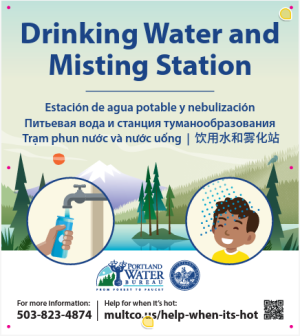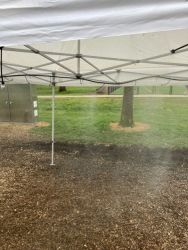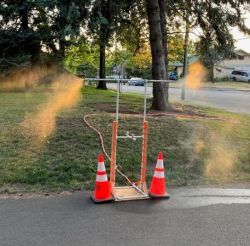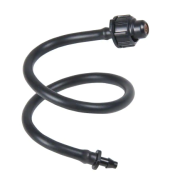JOB AID: Misting Stations
This job aid provides specific implementation guidance for misting stations as a public health heat intervention, following the City of Portland Severe Heat Operational Guidelines, which Portland Bureau of Emergency Management (PBEM) updates annually.
Job Aid content was last updated in August 2022. PBEM turned misting station operations over to the Water Bureau for subsequent heatwaves, but this job aid is preserved in case NETs are deployed to them in the future.
Background
In June 2021, Portland experienced an unprecedented heatwave over several days, reaching 117 degrees Fahrenheit. Following this incident, PBEM worked with Portland Parks & Recreation (PP&R) to build and deploy several misting stations in canopy tents around underserved heat island areas in the city that were staffed by NET volunteers, and in 2022 began to loan out misting stations in canopy tents to community-based organizations (CBOs). In 2022, Portland Water Bureau (PWB) began offering stand-alone misting stations with a water bottle filling option at several locations. As of 2023, PBEM continues to loan out misting tents to CBOs that provide lifeline services at their locations, while Parks has taken over offering misting tents to City-sponsored special events, and PWB will deploy unstaffed misting stations with potable water bottle fill station during heatwaves as a life safety measure.
During heatwaves, misting station locations and hours will be shared on the Multnomah County Help for When it's Hot webpage and 211info's website. Misting stations uniquely serve people who may not want to visit indoor cooling center locations.
Definitions
| Misting Tent | A 10x10 canopy tent with plastic hose piping attached to the canopy. Piping has small nozzles or holes to allow water to spray in a mist. |
| Misting Station | A free-standing PVC unit with bottle fill station. Accompanied by two orange cones and signage. |
Concept of Operations
Locations
The following parks have been identified by PP&R and PWB that meet the following criteria:
- Serve underserved neighborhoods (according to FEMA Community Resilience Index)
- Are in heat islands
- Have a lower occurrence of other public water and cooling amenities (pools, splash pads)
- Have easily accessible potable water hook ups (hose bib).
- Other considerations:
- Temporary closure of cooling amenities (i.e. splash pad offline for repair)
- Free lunch and play parks
These sites could be evaluated annually based on reported usage and changes in PP&R water amenities. These sites are not prioritized. Selection of which sites to activate should be determined based on availability and locations of emergency cooling centers.
- Normandale Park: 1260 NE 57th Ave
- Holladay Park: 1198 NE Multnomah St
- Glenhaven Park: 8000 NE Siskiyou St
- Knott Park: 2505 NE 117th Ave
- Argay Park: 3898 NE 141st Ave
- Floyd Light Park: 740 SE 106th Ave. (East Portland Community Center)
- Lynchwood Park: 17301 SE Haig St
- Lents Park: 4603 SE 92nd Ave.
- Mt Scott Community Center: 5527 SE 72nd Ave.
- Harney Park: 8498 SE 67th Ave.
- Powell Park: South of Powell on 22nd Ave
- Woodstock Park: 4701 SE 47th Ave
- McKenna Park: 6211 N Princeton St
- Dawson Park: N Vancouver Ave at N Morris St
Storage
Year round, the misting station supplies are stored by PBEM at their leased space at the Jerome Sears maintenance building (2730 S.W. Multnomah Blvd). Access can be obtained from the PBEM Operations Manager. During a severe heat event, misting stations may need to be deployed for multiple days. To save time, they can be stored at several locations approved by Parks.
Placement
- Misting stations: Set up on grass, not dirt or bark chips, to avoid mud. Do not put on paved surfaces, to avoid creating a slip hazard.
- A-boards: Put wherever it seems people may notice them, with an A-board and sign. Examples: Bus stops, sports fields.
Supplies
The following supplies belong to PBEM and are stored at the Jerome Sears maintenance building.
- (6) 10x10' Pop-up canopies.
- (26) A-boards
- (50) plastic folding chairs
- (6) White buckets. These will be filled with water on site and tied with rope to the canopies as weights.
- (6) 40' Black misting hoses. These have already been built with misting nozzles and are ready to go.
- Tote 1:
- (12) 25' white hoses. Zip tied in coils for year-round storage. This hose is similar to many garden hoses (pliable}. These will connect the water hook ups to the thicker black hoses.
- Tote 2:
- Black zip ties of varying size. Used to tie black misting hose to the canopy.
- White nylon rope. Use to tie white hoses in coils for year-round storage.
- Extra black misting hose, to be used to make more misting hoses. The plastic material is less pliable than the white hose, and can easily kink, which stops water flow. Kinks can be worked out by pressing with pliers.
- Tote 3:
- (7) Clear packaging tape. Use to tape signs to A-boards.
- (6) Water keys - (2) 1-size & (4) 4-size. The 4-size is the most useful. Water keys open hose bibs.
- (4) Pliers. These were used to build the misting hoses, but can be used to work out kinks in the black hose.
- (3) Duct tape. May not need, though has been used to tie coils for year round storage or to secure hose connections.
- (1) Scissors.
- (4) Wire cutters. These were used to build the misting hoses.
- Extra plastic connectors and end pieces.
- Rubber-palmed gloves (to avoid pinch points during canopy setup).
- Rite-in-theRain paper, pencils/ballpoint pens, clipboards for any note-taking.
- Sign-in/out sheets for staff (e.g. NET Form 2a).
Staffing
A team of two PBEM staff will set up and take down stations daily, with the assistance of volunteers who are on shift. PBEM staff are necessary because they can drive PBEM vehicles, have access to Jerome Sears, and can be entrusted with Parks security codes and keys. PBEM staff are responsible for following this job aid (see Responsibilities below). Misting stations must be staffed by two people at all times to avoid loss and ensure safety.
Generally, PBEM will ask Neighborhood Emergency Team {NET) volunteers to staff them for four hours at a time. Volunteers should have a PBEM NET Coordinator to report to. Volunteers should report to the PBEM NET Coordinator if any unsafe activity is occurring on site. After the severe weather event is over, the PBEM NET Coordinator will send a survey to the volunteers to collect feedback on their deployment.
Procedure
Build the mister
Supplies needed to build one station
- (1) 50 foot black rubber memory-flex irrigation hose.
- (16) DIG 12", 2 GPH mister end piece with memory-flex tubing (available from Home Depot: Model #7760F, see photo to right).
- (1) 25 PSI ¾" aerator hose nozzle attachment.
- (1) ½" black hose end cap.
- Drill with drill bits.
Directions
- Cut black rubber hose to length of canopy interior plus one leg (40 feet +10 feet = 50 feet).
- Do not need to add any on/off valves to the hose. Valves actually makes the hose more complicated to use because it's one more thing that needs to be checked when water isn't coming out of the hose.
- Using the power drill, drill ≈16 small holes for nozzles into the black hose every ≈1.5 feet. Start with a small bit size and if the nozzle attachment still doesn't fit, make the hole slightly bigger. Be careful not to drill out the other side. Leave a "tail" at one end (no nozzle attachments inserted) to drop down to the ground, which will be the end that attaches to the hose connected to the bib.
- Using the DIG 2 GPH Mister with Memory-Flex Tubing, insert the pointy non-nozzle end into the drill hole.
- To ensure a tight seal, make the drill hole slightly smaller than the diameter of the mister. Then, use moderate force to put the non-nozzle end of the mister into the main hose. The hose will be slightly flexible and accommodate this, closing and sealing around the tapered end of the attachment.
- Add aerator attachment to the hose's long "tail" that hangs to the ground, where it will be connected to the white hose that connects to the hose bub. Add the end cap to the end of the hose, which will be the end of the hose.
Assemble the station
- Choose station placement.
- Refer to station maps for hose bib locations.
- Stations can be maximum 50 feet from a hose bib.
- Set up stations on grass, not dirt or bark chips, to avoid mud. Do not put on paved surfaces, to avoid creating a slip hazard.
- Set up canopy.
- Takes at least two people, preferably four. If volunteers are on site, ask for their assistance.
- Depending on the canopy type, you may need to push up the middle as well as pull the legs away from each other.
- Don't rush. Be careful of pinching fingers.
- Attach black misting hose to canopy.
- Start with the aerator end, pointing down and near the ground. This will make it easier to connect to the white hose.
- Zip tie the black misting hose to the canopy. Be careful to avoid kinks by going slowly, unwinding the coil, and using pliers if needed to press kinks out.
- Connect misting hose to hose bib with white hose.
- Open hose bib with water key.
- Screw white hose onto hose bib.
- Screw white hose into black misting hose.
- Turn on water with water key.
- Set up A-boards with directional signage at main park entrance or busiest access point as needed.
Packing up for year-round storage
- Retrieve all misting station supplies and bring them to Jerome Sears.
- Assess whether any supplies should be replenished - use supply list as guide
- Store materials together in a storage room (not in a front bay).
- Tie all hose coils neatly.
- Close all storage boxes and stack together.
- Working with PBEM Operations, purchase additional material.



